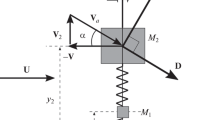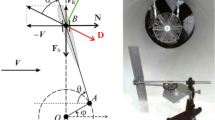Abstract
We consider a chain of several bodies that can move translationally along a horizontal line. The neighboring bodies are connected to each other by springs. One end of the chain is fixed, and on the other there is a body, which is a rectangular parallelepiped of a square section. The system is placed in a horizontal stationary medium flow perpendicular to the specified straight line. Under the assumption that the flow affects only the parallelepiped, the dynamics of this system are studied as a potential working element of an oscillatory wind power plant using the galloping effect. For a different number of bodies in a chain, different values of flow velocity and external load, periodic regimes in the system are studied. It is shown, in particular, that an increase in the number of bodies in a chain makes it possible to increase the maximum power that can be obtained using the device and to reduce the critical speed at which oscillations occur. A scheme for regulating the load resistance is proposed, aimed at ensuring the transition to an oscillatory mode with maximum power.







Similar content being viewed by others
REFERENCES
J. P. Den Hartog, “Transmission line vibration due to sleet,” Trans. AIEE 51, 1074–1086 (1932).
G. V. Parkinson and N. P. H. Brooks, “On the aeroelastic instability of bluff cylinders,” ASME. J. Appl. Mech. 28 (2), 252–258 (1961). https://doi.org/10.1115/1.3641663
G. V. Parkinson and J. D. Smith, “The square prism as an aeroelastic non-linear oscillator,” Q. J. Mech. Appl. Math. 17 (2), 225–239 (1964). https://doi.org/10.1093/qjmam/17.2.225
S. C. Luo, Y. T. Chew, and Y. T. Ng, “Hysteresis phenomenon in the galloping oscillation of a square cylinder,” J. Fluids Struct. 18 (1), 103–118 (2003). https://doi.org/10.1016/S0889-9746(03)00084-7
A. Barrero-Gil, A. Sanz-Andres, and G. Alonso, “Hysteresis in transverse galloping: The role of the inflection points,” J. Fluids Struct. 25 (6), 1007–1020 (2009). https://doi.org/10.1016/j.jfluidstructs.2009.04.008
V. D. Lyusin and A. N. Ryabinin, “On the galloping of prisms in a gas or liquid flow,” Tr. TsNII im. Akad. A.N. Krylova, 53 (337), 79–84 (2010).
P. W. Bearman, I. S. Gartshore, D. J. Maull, and G. V. Parkinson, “Experiments on flow-induced vibration of a square-section cylinder,” J. Fluids Struct. 1 (1), 19–34 (1987). https://doi.org/10.1016/s0889-9746(87)90158-7
M. Sarioglu, Y. E. Akansu, and T. Yavuz, “Flow around a rotatable square cylinder-plate body,” AIAA J. 44 (5), 1065–1072 (2006). https://doi.org/10.2514/1.18069
G.-Z. Gao and L.-D. Zhu, “Nonlinear mathematical model of unsteady galloping force on a rectangular 2:1 cylinder,” J. Fluids Struct. 70, 47–71 (2017). https://doi.org/10.1016/j.jfluidstructs.2017.01.013
M. Abdel-Rohman, “Design of tuned mass dampers for suppression of galloping in tall prismatic structures,” J. Sound Vib. 171 (3), 289–299 (1994). https://doi.org/10.1006/jsvi.1994.1121
V. Gattulli, F. Di Fabio, and A. Luongo, “Simple and double Hopf bifurcations in aeroelastic oscillators with tuned mass dampers,” J. Franklin Inst. 338, 187–201 (2001). https://doi.org/10.1016/S0016-0032(00)00077-6
M. M. Selwanis, G. R. Franzini, C. Beguin, and F. P. Gosselin, “Wind tunnel demonstration of galloping mitigation with a purely nonlinear energy sink,” J. Fluids Struct. 100, 103169 (2021). https://doi.org/10.1016/j.jfluidstructs.2020.103169
A. Barrero-Gil, G. Alonso, and A. Sanz-Andres, “Energy harvesting from transverse galloping,” J. Sound Vib. 329, 2873–2883 (2010). https://doi.org/10.1016/J.JSV.2010.01.028
H. L. Dai, A. Abdelkefi, U. Javed, and L. Wang, “Modeling and performance of electromagnetic energy harvesting from galloping oscillations,” Smart Mater. Struct. 24 (4), 045012 (2015). https://doi.org/10.1088/0964-1726/24/4/045012
P. Hemon, X. Amandolese, and T. Andrianne, “Energy harvesting from galloping of prisms: A wind tunnel experiment,” J. Fluids Struct. 70, 390–402 (2017). https://doi.org/10.1016/j.jfluidstructs.2017.02.006
U. Javed, A. Abdelkefi, and I. Akhtar, “An improved stability characterization for aeroelastic energy harvesting applications,” Commun. Nonlinear Sci. Numer. Simul. 36, 252–265 (2016). https://doi.org/10.1016/j.cnsns.2015.12.001
T. Tan and Z. Yan, “Analytical solution and optimal design for galloping-based piezoelectric energy harvesters,” Appl. Phys. Lett. 109, 253902 (2016). https://doi.org/10.1063/1.4972556
K. F. Wang, B. L. Wang, Y. Gao, and J. Y. Zhou, “Nonlinear analysis of piezoelectric wind energy harvesters with different geometrical shapes,” Arch. Appl. Mech. 90, 721–736 (2020). https://doi.org/10.1007/s00419-019-01636-8
D. Zhao, X. Hu, T. Tan, Zh. Yan, and W. Zhang, “Piezoelectric galloping energy harvesting enhanced by topological equivalent aerodynamic design,” Energy Conv. Manage. 222, 113260 (2020). https://doi.org/10.1016/j.enconman.2020.113260
M. Zhang, A. Abdelkefi, H. Yu, X. Ying, O. Gaidai, and J. Wang, “Predefined angle of attack and corner shape effects on the effectiveness of square-shaped galloping energy harvesters,” Appl. Energy 302, 117522 (2021). https://doi.org/10.1016/j.apenergy.2021.117522
D. Vicente-Ludlam, A. Barrero-Gil, and A. Velazquez, “Enhanced mechanical energy extraction from transverse galloping using a dual mass system,” J. Sound Vib. 339, 290–303 (2015). https://doi.org/10.1016/j.jsv.2014.11.034
D. Karlicic, M. Cajic, and S. Adhikari, “Dual-mass electromagnetic energy harvesting from galloping oscillations and base excitation,” Proc. Inst. Mech. Eng., Part C 235 (20), 4768–4783 (2021). https://doi.org/10.1177/0954406220948910
Yu. D. Selyutsky, “Dynamics of a wind turbine with two moving masses using the galloping effect,” Mech. Solids 58 (2), 426–438 (2023). https://doi.org/10.3103/S0025654422600507
M. Dosaev, “Interaction between internal and external friction in rotation of vane with viscous filling,” Appl. Math. Modell. 68, 21–28 (2019). https://doi.org/10.1016/j.apm.2018.11.002
Q. Wang, J. Goosen, and F. Van Keulen, “A predictive quasi-steady model of aerodynamic loads on flapping wings,” J. Fluid Mech. 800, 688–719 (2016). https://doi.org/10.1017/jfm.2016.413
M. K. Abohamer, J. Awrejcewicz, R. Starosta, T. S. Amer, and M. A. Bek, “Influence of the motion of a spring pendulum on energy-harvesting devices,” Appl. Sci. 11, 8658 (2021). https://doi.org/10.3390/app11188658
L. A. Klimina, “Method for forming autorotations in controllable mechanical system with two degrees of freedom,” J. Comput. Syst. Sci. Int. 59 (6), 817–827 (2020).
Funding
This work was supported by the Russian Science Foundation, grant no. 22-29-00472.
Author information
Authors and Affiliations
Corresponding author
Ethics declarations
The authors declare that they have no conflicts of interest.
Additional information
Publisher’s Note.
Pleiades Publishing remains neutral with regard to jurisdictional claims in published maps and institutional affiliations.
Rights and permissions
About this article
Cite this article
Lokshin, B.Y., Selyutskiy, Y.D. Oscillations of a Wind Power Plant with Several Moving Masses Using the Galloping Effect. J. Comput. Syst. Sci. Int. 62, 838–849 (2023). https://doi.org/10.1134/S1064230723050118
Received:
Revised:
Accepted:
Published:
Issue Date:
DOI: https://doi.org/10.1134/S1064230723050118




